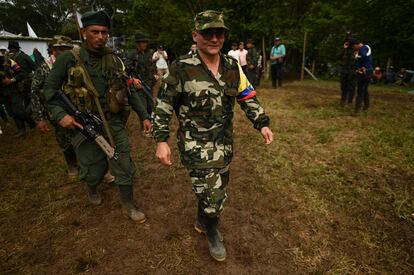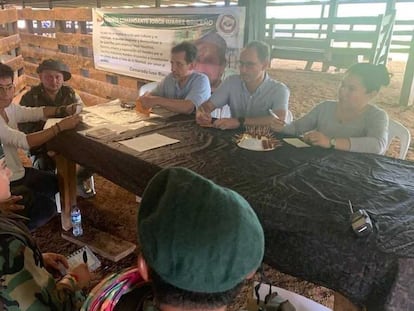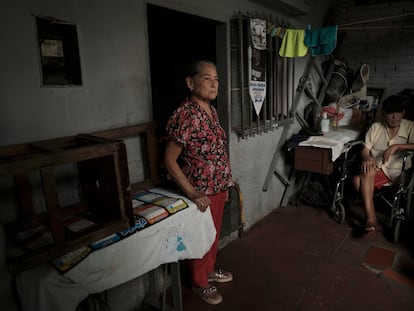Iván Mordisco and the resurrection of an armed group in Colombia
The leader of the FARC dissidents – who was once presumed dead – is currently negotiating with the government of President Gustavo Petro

Iván Mordisco was resurrected twice. Not only did he reappear triumphantly after President Iván Duque left him for dead at the end of his term… but the current government of Gustavo Petro has given his armed group a new life.
Over the last few years, the self-styled commander of the FARC dissidents – a breakaway group from the extinct FARC guerrillas – has been linked to drug-trafficking and illegal mining. Today, his little political group is seeking to negotiate a peace deal in Norway.
Iván Mordisco entered the public eye on May 3, 2016… although his journey in the jungle as part of the armed struggle has been going on for more than 22 years. His real name is Nestor Gregorio Vera Fernandez. Seven years ago, when the FARC leadership was negotiating in Havana with then-President of Colombia Juan Manuel Santos, Vera announced, via statement, that a group of guerrillas led by him would not hand over their weapons.
“With the determination to continue the armed struggle, the First Front of the former FARC-EP speaks for dissatisfied guerrilla militants, who, in the different blocs and fronts, don’t feel represented or protected by the decisions made by the negotiating team,” explains an internal document by the Colombian military, which came to light after the 2022 Guacamaya leaks. This was an early warning from the military regarding the municipality of Miraflores, in the southern region of Guaviare, where Mordisco’s group threatened civilian populations and ex-combatants who were going along with the peace process.
Mordisco “is seen as dogmatic [and] radical for [not] having adapted to the changes of the war [with the government] and always being in disagreement with an armistice or political negotiation.” This is from a 2016 report on the origins of the FARC dissidents, prepared by the Ideas for Peace Foundation (FIP), which also notes that he has undergone a process of “criminal degradation.” He was distinguished by an openly hostile attitude towards the agreements and towards those who promoted them. Mordisco – who is extremely violent – also rejects illicit crop substitution programs and demonstrates deep mistrust towards civilian populations, particularly Indigenous communities.
The First Front is one of the most representative structures of the FARC, operating in three departments (regions) in the southeast of the country: Vaupés, Guaviare and Meta. These areas – along with Caquetá – are known as the so-called “deforestation arc.” According to another report by the military high command, Mordisco’s public announcement of continuing to bear arms caused Gentil Duarte – a FARC leader – to return to Colombia from Cuba to “subdue alias Iván Mordisco.” However, according to the military’s timeline, in September of 2016 – as Colombia celebrated the imminent demobilization of some 13,000 combatants – Duarte himself withdrew from the peace process to form a separate group of dissidents. A year later, Duarte and Mordisco created a “temporary secretariat.”
During a meeting in El Retorno, in Guaviare, they established a four-year plan: the first two for growth (2018 and 2019) and the other two (2020 and 2021) to “do great actions,” with a goal of adding 6,000 armed men to the offshoot. They also agreed that they would fine local ranchers and peasants about 200,000 Colombian pesos ($45) per kilo of coca, among other illegal charges. At the beginning of 2022, his group – according to documents from the General Command of the Military Forces – had “approximately 3,239 members.”
More than 90% of the peace signatories have fulfilled their commitments. They remain legal and are advancing in their reincorporation process. The destruction by the government that was initially feared never occurred. For this reason, the FARC dissidents have relied heavily on forced recruitment – often of minors. An analysis by the International Federation of Journalists (IFJ) points out that “the dissidents are a federation of groups under the same umbrella, but with different interests, ways of operating, and degrees of articulation, as well as great autonomy in their operation at the territorial level.”
Both Duarte and Mordisco were central to the escalation of the war after the disarmament of the FARC. In regions like Arauca – on the border with Venezuela – they confronted the ELN guerrilla group, fighting over “mobility corridors, as well as hegemony over the illicit economies present in the border area, [which are] the main source of financing for the strengthening of its armed component and support networks for terrorism,” according to the Colombian military.
A letter sent by the Ombudsman’s Office to the military mentions the murder of three peasants in the Sumapaz region, a rural area near Bogotá, which occurred in 2021. In May of that same year, an intelligence report on the dissidents’ connections revealed that there were disputes between the Mordisco group and the Segunda Marquetalia – under the command of Iván Márquez – over “control of the eastern border (with Venezuela) and drug trafficking.”
In Colombia, six internal armed conflicts persist. Half of them involve dissident factions, according to an annual summary by the International Committee of the Red Cross (ICRC). The United States government considers both Márquez’s Segunda Marquetalia and Mordisco’s Central General Staff to be terrorist organizations.
In 2021, when referring to the dissident faction commanded by Mordisco and Duarte, the Military Forces of Colombia said: “These two subjects [are] committing crimes mainly in the departments of Caquetá and Guaviare, in 103 municipalities and 15 departments.” The army attributed the attack on Brigade No. 30 in Cúcuta to them, as well as the shots that were fired at a helicopter carrying former President Iván Duque in that same city.
Gentil Duarte seemed to emerge as the big winner in the confusing war between dissident factions… until he was assassinated in May of 2022 across the border with Venezuela, according to Colombian press and intelligence information. Two months later, outgoing President Duque announced that the army had achieved a “coup at the core of the FARC dissident structure.” The “neutralization” of Iván Mordisco – in the words of the then-Defense Minister Diego Molano – was the “final blow to the dissidents.”
But Mordisco reappeared two months later via video, accompanied by a dozen armed men, in which he announced his willingness to talk with the new administration of Gustavo Petro, within the framework of the president’s “total peace” policy. And, in case anyone had any doubts, he reappeared this past Sunday, wearing sunglasses and a military uniform, in the Yarí Planes. The dissidence that he leads announced that it would begin negotiations with the government on May 16 of this year.
Sign up for our weekly newsletter to get more English-language news coverage from EL PAÍS USA Edition
Tu suscripción se está usando en otro dispositivo
¿Quieres añadir otro usuario a tu suscripción?
Si continúas leyendo en este dispositivo, no se podrá leer en el otro.
FlechaTu suscripción se está usando en otro dispositivo y solo puedes acceder a EL PAÍS desde un dispositivo a la vez.
Si quieres compartir tu cuenta, cambia tu suscripción a la modalidad Premium, así podrás añadir otro usuario. Cada uno accederá con su propia cuenta de email, lo que os permitirá personalizar vuestra experiencia en EL PAÍS.
¿Tienes una suscripción de empresa? Accede aquí para contratar más cuentas.
En el caso de no saber quién está usando tu cuenta, te recomendamos cambiar tu contraseña aquí.
Si decides continuar compartiendo tu cuenta, este mensaje se mostrará en tu dispositivo y en el de la otra persona que está usando tu cuenta de forma indefinida, afectando a tu experiencia de lectura. Puedes consultar aquí los términos y condiciones de la suscripción digital.
More information
Archived In
Últimas noticias
Most viewed
- Reinhard Genzel, Nobel laureate in physics: ‘One-minute videos will never give you the truth’
- Oona Chaplin: ‘I told James Cameron that I was living in a treehouse and starting a permaculture project with a friend’
- Pablo Escobar’s hippos: A serious environmental problem, 40 years on
- Why we lost the habit of sleeping in two segments and how that changed our sense of time
- Chevy Chase, the beloved comedian who was a monster off camera: ‘Not everyone hated him, just the people who’ve worked with him’










































